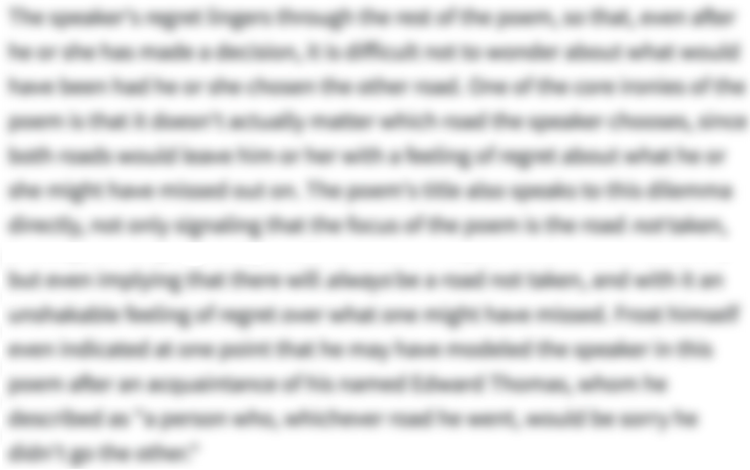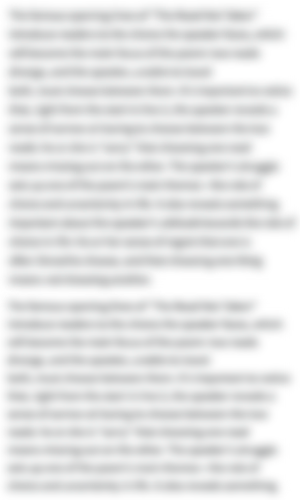The Full Text of “London Snow”
1When men were all asleep the snow came flying,
2In large white flakes falling on the city brown,
3Stealthily and perpetually settling and loosely lying,
4 Hushing the latest traffic of the drowsy town;
5Deadening, muffling, stifling its murmurs failing;
6Lazily and incessantly floating down and down:
7 Silently sifting and veiling road, roof and railing;
8Hiding difference, making unevenness even,
9Into angles and crevices softly drifting and sailing.
10 All night it fell, and when full inches seven
11It lay in the depth of its uncompacted lightness,
12The clouds blew off from a high and frosty heaven;
13 And all woke earlier for the unaccustomed brightness
14Of the winter dawning, the strange unheavenly glare:
15The eye marvelled—marvelled at the dazzling whiteness;
16 The ear hearkened to the stillness of the solemn air;
17No sound of wheel rumbling nor of foot falling,
18And the busy morning cries came thin and spare.
19 Then boys I heard, as they went to school, calling,
20They gathered up the crystal manna to freeze
21Their tongues with tasting, their hands with snowballing;
22 Or rioted in a drift, plunging up to the knees;
23Or peering up from under the white-mossed wonder,
24‘O look at the trees!’ they cried, ‘O look at the trees!’
25 With lessened load a few carts creak and blunder,
26Following along the white deserted way,
27A country company long dispersed asunder:
28 When now already the sun, in pale display
29Standing by Paul’s high dome, spread forth below
30His sparkling beams, and awoke the stir of the day.
31 For now doors open, and war is waged with the snow;
32And trains of sombre men, past tale of number,
33Tread long brown paths, as toward their toil they go:
34 But even for them awhile no cares encumber
35Their minds diverted; the daily word is unspoken,
36The daily thoughts of labour and sorrow slumber
37At the sight of the beauty that greets them, for the charm they have broken.
-
“London Snow” Introduction
-
"London Snow" is an 1890 poem by Robert Bridges (1844-1930). In the poem, Bridges writes of a London whose grime and drudgery are briefly transformed by heavy snowfall. Drawing on the tradition of the Romantic poets, he pits the sublime power of nature against the grinding toil of the Industrial Revolution. While the snow's unifying and perfecting power is fleeting, it offers London's weary citizens a glimpse of a better world.
-
-
“London Snow” Summary
-
The poem begins with heavy snowfall during the night, while all the citizens are sleeping. The snow's whiteness steadily covers up the brown of the city, slowly veiling and quieting all the sights and sounds of sleepy London. Though unrushed, the snowfall is persistent, and its accumulation—on roads, rooftops, and railings—levels out all of the city's irregularities.
Snow falls throughout the whole night, until seven inches of soft snow has piled up. When the morning comes, the clouds part in the cold sky, and the reflected glare of the dawn light on the snow wakes London's citizens unusually early. The Londoners gaze in wonder and awe at the snow's vivid whiteness and the serious silence that fills the air. The sounds of the city's usual morning routine—of wheels rumbling down the street, footsteps, and early chatter—have all been muffled.
The speaker then hears boys shouting on their way to school, gathering up the heavenly snow to taste it, throwing snowballs, and playing rambunctiously in the snowdrifts that come up to their knees. They look up at the snow-covered tree limbs and repeatedly call out to each other in awe. A few carts, carrying fewer things than usual, creak and thud through the empty, white streets on their way out of the city.
The pale sun rises above the dome of St. Paul's Cathedral, and its shining beams herald the beginning of the day's work. As the city's workers head out of their homes, they now have to fight against the snow. Seemingly endless lines of serious-looking laborers trudge to their jobs, leaving muddy brown paths in their wake. But even these workers' burdens are lightened by the distraction of the snow. With their habitual worries laid (however briefly) to rest, the men experience a glimpse of beauty that has the power to shake them out of the hypnotized inattention of their daily lives.
-
-
“London Snow” Themes
-
The Power and Fragility of Nature
In “London Snow,” heavy snowfall transforms grimy Victorian London into alien terrain: overnight, the bustling city becomes white, quiet, crystalline, and unearthly. The snow hides “difference” and makes “unevenness even”; in other words, it makes the city look not just beautiful but perfect and unified. The citizens respond with wonder—but their interactions with the snow quickly spoil its pristine surface; the snow offers the laboring Londoners only a momentary glimpse of a different, better world. Nature in “London Snow” is thus both fragile and powerful. The snow’s unifying perfection is quickly spoiled by the grinding pressure of daily life—but the memory of that perfection remains, and has the power to break daily life’s oppressive “charm.”
The poem begins with snowfall in the night, unobserved by the sleeping city. The snow is unrushed but inexorable: its power is not in force, but in slow gathering. It is personified as stealthy and lazy, and presented in contrast with London’s human inhabitants. It is an active force, with power and intent (“Hiding difference, making unevenness uneven”), but its unhurried transformation is very different from the pressured, grinding labors of London’s citizens. As such, its work can only be perfected when humans are all asleep.
When the sun rises, the people of London awaken to a transformed landscape, and respond as a single entity. The snow enchants and unifies a normally discordant and downtrodden populace, leveling the landscape and the citizens at once. The city’s population arrives in the poem as a unified body. “All woke earlier,” and the city’s collective “eye marvelled” and “ear hearkened.” The speaker then moves into a specific perspective; an “I” appears, and observes schoolboys playing in the snow.
The schoolboys are another kind of collective body, speaking for the city in one voice (“‘O look at the trees,’ they cried, ‘O look at the trees!’”). In their youthful wonder at and engagement with the snow—they don’t just see the snow’s beauty, they taste it—they embody the city’s own awe and delight. The use of the schoolboys as the city’s voice also speaks to the snow’s rejuvenating power: the city is not just perfected by the snow, but made newly young. The snow makes the city capable of wonder and joy in the same way that schoolboys are.
Soon enough, however, daily reality inevitably emerges again as the demands of the workday mar the snow’s surface. Eventually, “trains of sombre men, past tale of number / Tread long brown paths” in the snow as they emerge to make their way to work. The image is both quotidian and visionary, almost apocalyptic: the working men become an endless train of drudging marchers. Where the snow unifies the people of London, the force of society and the daily pressures of labor make them into a dehumanized mass.
But these archetypal laborers are re-humanized by their experience of the snow’s beauty. Its transcendent vision of shared, unifying wonder wipes their worries away—if only for a little while. The snow is both an enchantment and the means of breaking an enchantment: the shining city it produces is only an impermanent illusion, but that illusion in itself has the power to break the spell of drudgery cast by the workaday Victorian industrial world.
The poem thus presents a vision that is at once realistic and idealistic. It does not shy from the painful realities of daily life, but holds out hope for a better, more harmonious world—one people can glimpse especially through the experience of natural beauty.
- See where this theme is active in the poem.
-
-
Line-by-Line Explanation & Analysis of “London Snow”
-
Lines 1-4
When men were all asleep the snow came flying,
In large white flakes falling on the city brown,
Stealthily and perpetually settling and loosely lying,
Hushing the latest traffic of the drowsy town;The poem begins in a landscape without human beings. The first line tells readers that "men were all asleep," a fairy-tale-like image in a big city (where, in reality, you could count on at least someone being awake all night!). This line sets the stage with a sense of mystery and enchantment, later emphasized by the speaker's description of the snow as "stealthy": this snow falls unseen by humans (and perhaps could only fall unseen by humans).
Much of this stanza focuses on the snow's action, describing the way the snow moves and gathers. The speaker evokes the snow's accumulation through the use of the past progressive tense (which is the technical way to describe the use of verbs ending in "-ing" in the past tense). Rather than saying that the snow "flew" or "fell," the speaker says that it came "flying," "falling," etc. The feeling of ongoing action these "-ing" verbs create suggests a steady, accumulative transformation, not an instantaneous one. The reader thus gets a private window onto a slow process that the sleeping Londoners only see all at once after the city's transformation is complete.
The snow performs three major transformations in the poem: it makes the city quiet where it was noisy, white where it was brown, and even where it was uneven. The speaker's use of alliteration and sibilance in these opening lines helps to build a picture of the smooth silent landscape the snow is creating: the softness of /s/ sounds and the regularity of repeated initial letters mimics the snow's gentle, inescapable unification of the city. In addition to sibilance, note how the frequent consonance of /w/, /l/, and /f/ sounds throughout these lines adds to their sleepy, gentle, muffled quality:
When men were all asleep the snow came flying,
In large white flakes falling on the city brown,
Stealthily and perpetually settling and loosely lying,
Hushing the latest traffic of the drowsy town;The speaker will repeat these sounds throughout the first nine lines of the stanza. There is a great deal of assonance throughout these lines as well. Note the short /eh/, long /ee/, /ow/, /ay/, and long and short /i/ sounds:
When men were all asleep the snow came flying,
In large white flakes falling on the city brown,
Stealthily and perpetually settling and loosely lying,
Hushing the latest traffic of the drowsy town;All together, these lines are intensely musical—filled with repetitive, incessant sounds that reflect the hypnotic nature of the falling snow.
Finally, both the snow and London are personified here and throughout the poem. The snow has agency—the ability to be "stealthy," for instance—and London is described as being "drowsy" because it is nighttime. This personification reflects the poem's thematic idea of unity, presenting both the snow and the city itself in this moment as cohesive, unified entities.
-
Lines 5-9
Deadening, muffling, stifling its murmurs failing;
Lazily and incessantly floating down and down:
Silently sifting and veiling road, roof and railing;
Hiding difference, making unevenness even,
Into angles and crevices softly drifting and sailing.

Unlock all 309 words of this analysis of Lines 5-9 of “London Snow,” and get the Line-by-Line Analysis for every poem we cover.
Plus so much more...
Get LitCharts A+ -
Lines 10-18
All night it fell, and when full inches seven
It lay in the depth of its uncompacted lightness,
The clouds blew off from a high and frosty heaven;
And all woke earlier for the unaccustomed brightness
Of the winter dawning, the strange unheavenly glare:
The eye marvelled—marvelled at the dazzling whiteness;
The ear hearkened to the stillness of the solemn air;
No sound of wheel rumbling nor of foot falling,
And the busy morning cries came thin and spare. -
Lines 19-24
Then boys I heard, as they went to school, calling,
They gathered up the crystal manna to freeze
Their tongues with tasting, their hands with snowballing;
Or rioted in a drift, plunging up to the knees;
Or peering up from under the white-mossed wonder,
‘O look at the trees!’ they cried, ‘O look at the trees!’ -
Lines 25-27
With lessened load a few carts creak and blunder,
Following along the white deserted way,
A country company long dispersed asunder: -
Lines 28-30
When now already the sun, in pale display
Standing by Paul’s high dome, spread forth below
His sparkling beams, and awoke the stir of the day. -
Lines 31-33
For now doors open, and war is waged with the snow;
And trains of sombre men, past tale of number,
Tread long brown paths, as toward their toil they go: -
Lines 34-37
But even for them awhile no cares encumber
Their minds diverted; the daily word is unspoken,
The daily thoughts of labour and sorrow slumber
At the sight of the beauty that greets them, for the charm they have broken.
-
-
“London Snow” Symbols
-
Snow
Snow is a complex symbol in the poem, representing both nature at large—in its power and in its fragility—and a transcendent ideal of life and unity.
The snow's strength, in the poem, is presented in contrast with human ideas of power and labor. It does not use force to achieve its overwhelming effects, but rather a steady, stealthy accumulation. Yet its gentleness has the capacity to utterly transform London. The snow also presents a vision of an unstained world. The speaker's emphasis on its whiteness suggests purity. And the London the citizens first see under the snow is not just beautiful, but unspoiled—as is made painfully clear when the workers begin to tread the snow into the mud and the usual "brown" paths reemerge. In these qualities, the snow stands for all of nature: a leveling, unifying, beautiful power that is nevertheless all too easily scarred by brute human force.
The snow's ability to unite what seemed different also has a mystical edge as well, as readers can see when it's described as "manna" and a "wonder." In covering the city in an even blanket, "hiding differences" and bringing the citizens together in shared joy, the snow paradoxically represents something that's usually buried under day-to-day life: a transcendent human unity.
- See where this symbol appears in the poem.
-
Workers
The poem's vision of an endless toiling line of workers presents the plight not only of the downtrodden Victorian laborer, but of humanity—and perhaps of urban life itself—as a whole. Caught up in thoughtless repetition, distracted by their own cares, and kept busy by inhumane societal demands, urban human beings become unable to see the world's great and unifying beauty.
The speaker's use of the word "trains" is particularly interesting. This represents the line of workers not only as lengthy, but homogenous, and almost mechanical. In effect, this dehumanizes the workers—making them mere cogs in a machine. This image raises particular Victorian concerns about the effects of the Industrial Revolution on the soul.
- See where this symbol appears in the poem.
-
-
“London Snow” Poetic Devices & Figurative Language
-
Alliteration
Alliteration in "London Snow" often supports the poem's themes of unification—for better and for worse. In a poem that's interested in how a busy, noisy city is brought together in shared delight, alliteration helps to create connections between unlike things. It often also mimics the physical qualities of the things it's used to describe.
For instance, in the first stanza of the poem, repeated soft sounds—/s/, /f/, /l/, /m/—help to evoke the softness, lightness, and muted nature of the snow. (Note that the words "soft," "light," and "muted" all use those very letters!) Take phrases like "flakes falling" and "Silently sifting." This pattern of soft-voiced alliteration reappears throughout the poem, reliably appearing wherever the snow is described.
Within all this softness, harder alliteration is used to describe the physical components of the city: for instance, in line 7, where "road, roof and railing" are all veiled by the snow. The repeated /r/ sound here contrasts with the gentle, quiet sounds attached to the snow, helping to establish both the city's literal and metaphorical roughness and to pull the city together as one conglomeration of human-made structures.
Alliteration also helps to give a shared identity to the "country company" (line 27), and to the laborers at the end of the poem:
trains of sombre men, past tale of number,
Tread long brown paths, as toward their toilThe hard repeated /t/ sounds mimic the repetitive rhythm of their trudge to work.
- See where this poetic device appears in the poem.
-
Sibilance


Unlock all 306 words of this analysis of Sibilance in “London Snow,” and get the poetic device analyses for every poem we cover.
Plus so much more...
Get LitCharts A+ -
Consonance
-
Assonance
-
Personification
-
Enjambment
-
Asyndeton
-
Caesura
-
Imagery
-
Repetition
-
-
“London Snow” Vocabulary
Select any word below to get its definition in the context of the poem. The words are listed in the order in which they appear in the poem.
- Perpetually
- Stifling
- Incessantly
- Veiling
- Crevices
- Uncompacted
- Hearkened
- Solemn
- Manna
- White-mossed
- Dispersed
- Asunder
- Paul's high dome
- Sombre
- Past tale of number
- Toil
- Encumber
Perpetually-
Constantly or unchangingly.
- See where this vocabulary word appears in the poem.
-
Form, Meter, & Rhyme Scheme of “London Snow”
-
Form
While "London Snow" does not use a named poetic form (it's not an ode or a sonnet, for example), its shape does reflect its content. Using a lengthy and unbroken sequence of lines of roughly equal length, the poem's smooth surface mimics the evenness of the snow it describes.
The poem doesn't space out its stanzas, but it does contain thematic division points hidden at regular intervals. The poem's use of terza rima, with its weaving one-two-three waltz-pattern of rhymes, means that the poem divides into three groupings of nine lines each, and a final one of ten lines:
- The first group describes the accumulation of snow overnight.
- The second describes Londoners then waking up to the snow and taking in the surreal sense of calm and silence.
- The third describes people actually interacting with the snow joyfully before it's spoiled.
- And the fourth describes the day resuming as normal, with people trudging through the snow on the way to work and, in doing so, destroying its beauty.
The concluding tenth line of this fourth section does what it describes: it breaks the pattern. It literally disrupts the rhyme scheme, and it also breaks up the relatively steady line lengths in being much longer than any other line in the poem. To emphasize this, the line even uses "broken" as its final word.
-
Meter
The poem's meter is irregular. For instance, the first line of the poem seems to be in straightforward iambic pentameter. This means that there are five iambs per line, for a total of ten syllables (an iamb is a poetic foot with an unstressed-stressed, or da DUM, beat pattern:
When men were all asleep the snow came flying,
Already things aren't perfect though, since there's a dangling, unstressed syllable at the end (technically called a feminine ending). And almost immediately, the speaker breaks this pattern. Take line 2:
In large white flakes falling on the city brown,
While it's possible to read differently, there are clearly additional stresses in this line. These add emphasis to the snow itself—with the triple stress of "large white flakes"—as well as their action—"falling." The trochee (stressed-unstressed) of "falling" in fact echoes the action itself, as the word seems to descend from the high of "fal-" to the softness of "-ling."
There are many trochees and spondees (stressed-stressed, as in "white flakes" above) throughout the poem. The speaker's use of meter thus seems likely influenced by the experimental technique of Bridges's friend and fellow poet, Gerard Manley Hopkins. Hopkins was the mastermind of something called "sprung rhythm," which, very simply put, is a meter in which feet usually consist of a stressed syllable followed by up to four unstressed syllables. The basics units of sprung rhythm are trochees and spondees, and it's meant to sound like natural speech. Something like sprung rhythm can be seen in line 3:
Stealthily and perpetually settling and loosely lying,
And again line 7:
Silently sifting and veiling road, roof and railing;
This meter—with its initial stressed beats seeming to cover those that follow, DUM da da—mirrors the work of the snow as it covers the city. Rather than using the steady rhythmic pulse of iambic pentameter, with its regular peaks and troughs, the poem's mixture of stresses gives the lines a gentle, lilting feel that reflects the swirling and falling of the snow.
-
Rhyme Scheme
"London Snow" is written in terza rima, a rhyme scheme invented and popularized by the great medieval Italian poet Dante Alighieri (c. 1265-1321). Terza rima is an interlocking pattern of three rhyme words that runs:
ABA BCB CDC DED
...and so on. It's a relatively rare rhyme scheme in English, as English has far fewer rhyming words than Italian and the other Romance languages (as readers can see when Bridges rhymes "even" with "seven" and "heaven" in lines 8, 10, and 12).
The speaker's use of terza rima supports the poem's theme of nature's power, harmony, and unity—and its fragility. A poem in terza rima doesn't have a natural stopping point, but can go on indefinitely. Bridges chooses to end his poem on the word "broken," emphasizing both the snow's power to break the "charm" of daily routine and its impermanence.
Bridges may also have used terza rima to make a connection with Dante's Divine Comedy, where the rhyme scheme's infinite dance of threes serves as an image of the relationship of the Holy Trinity and the joys of heaven. The snow's perfect unity can't last on Earth, but alongside the use of terza rima, Bridges's references to St. Paul's cathedral and manna raise the possibility of less fleeting perfections in a Christian afterlife.
-
-
“London Snow” Speaker
-
The speaker of "London Snow" is both omniscient and specific. At the beginning of the poem, the speaker seems to have the power to perceive the snow's action during the night, though "men were all asleep." But in the middle of the poem, the speaker becomes an "I," who can hear schoolboys in the street. This makes the speaker feel like a specific character, a single resident of London. By the poem's end,however, the speaker's perspective has again broadened out, and the speaker talks with authority of the shared thoughts and feelings of the men walking to work.
The speaker at once shares London's general joy, and stands apart, observing this all. The speaker is deeply moved by both the unifying beauty of the snow and the sorrows of daily life in London. By keeping the speaker's identity vague and nonspecific, the poem allows readers to find themselves in the speaker—for readers to share in the speaker's wonder and despair.
-
-
“London Snow” Setting
-
The poem is set in London. While the time period isn't specified, the poem's reference to the city's brownness and to rumbling carts help to place it in the period of its composition: the late 19th century, when English cities were notoriously dirtied by the smoke of the Industrial Revolution. The poem's horror at the dehumanizing toil of the workers also gives readers a taste of Victorian ethics and concerns.
London undergoes two metamorphoses over the course of the poem: the snow makes the city white and shining, and the emerging workers begin to undo that transformation. Bridges's reuse of the word "brown" at the beginning and end of the poem suggests the reemergence of the city's usual state.
-
-
Literary and Historical Context of “London Snow”
Literary Context
A contemporary of the lush, florid Pre-Raphaelites (a Victorian-era school of artists and poets who advocated for a return to medieval themes and aesthetics), Bridges resisted the prevailing cultural winds of his time. He was the founder of the Society for Pure English, and his poetic choices reflect his fondness for the poetic themes of the earlier Romantic era. This doesn't mean romantic in the "love" sense; rather, Romantic poetry focused on subjects such as the wisdom of childhood and the sublime power of nature.
It's also possible to see the influence of earlier poets like William Wordsworth and William Blake in Bridges's writing about London. In Wordsworth's "Composed upon Westminster Bridge"and Blake's "London," readers can see how Wordsworth's experience of London in a moment of strange quiet and Blake's apocalyptic condemnation of industrialized cruelty might have influenced "London Snow."
Bridges was, however, also a great champion of the experimental verse of his friend and contemporary Gerard Manley Hopkins ("God's Grandeur," "Pied Beauty," "The Caged Skylark"). Hopkins's idea of "sprung rhythm" (in which lines of verse are measured solely by number of stresses, rather than both number and pattern) has a clear influence on Bridges's own work.
Historical Context
Bridges's horror at the mechanization of humanity and his wistfulness for natural beauty are deeply rooted in the concerns of his era. "London Snow" was written in the aftermath of the Industrial Revolution, which transformed the English economy and the English way of life. As workers began slowly to leave traditional occupations in the countryside, English cities—London in particular—became crowded and filthy. The famous "London fog" was not just fog, but a toxic haze of coal smoke.
Many writers of the time were deeply alarmed by these developments, worrying not only for the beauty of nature crushed under the heel of industry, but for the human soul in a world that seemed built for machines. This poem clearly reflects such anxieties.
-
More “London Snow” Resources
-
External Resources
-
More About Robert Bridges — A short biography and links to more of Bridges's poems.
-
Bridges as Poet Laureate — Some background on Bridges's public role as England's Poet Laureate.
-
The Poem Out Loud — One reader's interpretation of the poem.
-
The Poem Out Loud - Again! — A very different reading. Compare them and consider the effect the different voices have!
-
St. Paul's Cathedral — Some background on St. Paul's and its history as a London symbol.
-
-
LitCharts on Other Poems by Robert Bridges
-











